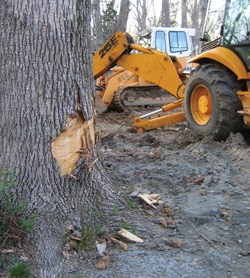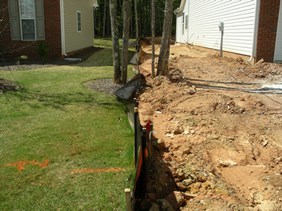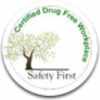 The construction process can be devastating to surrounding trees when there is no protection plan in place. Broken branches are commonplace but damage done underground may be even worse. By pre-planning, it is possible to lessen the impacts construction causes.
Ask your builder to mark the areas where heavy equipment will be used and where mounds of sand and building materials will be stored. Make sure the boundaries are marked and adhered to because soil compaction is the single most reason that urban trees die.
Approximately 90-95 percent of a tree’s root system is in the top three feet of soil, and more than half is in the top one foot. The part of this root system in which construction damage should be avoided is called the Protected Root Zone (PRZ). One common method used to identify the PRZ is to define it as the “dripline”–the area directly below the branches of the tree. For an extra measure of protection, extend the protection zone beyond the dripline as much as possible.
Moving large amounts of soil within the PRZ usually kills a tree. Except where absolutely necessary, avoid disruptions to the natural contour of the site or shift them well outside the PRZ.
The construction process can be devastating to surrounding trees when there is no protection plan in place. Broken branches are commonplace but damage done underground may be even worse. By pre-planning, it is possible to lessen the impacts construction causes.
Ask your builder to mark the areas where heavy equipment will be used and where mounds of sand and building materials will be stored. Make sure the boundaries are marked and adhered to because soil compaction is the single most reason that urban trees die.
Approximately 90-95 percent of a tree’s root system is in the top three feet of soil, and more than half is in the top one foot. The part of this root system in which construction damage should be avoided is called the Protected Root Zone (PRZ). One common method used to identify the PRZ is to define it as the “dripline”–the area directly below the branches of the tree. For an extra measure of protection, extend the protection zone beyond the dripline as much as possible.
Moving large amounts of soil within the PRZ usually kills a tree. Except where absolutely necessary, avoid disruptions to the natural contour of the site or shift them well outside the PRZ.
 Do a quick site inventory of existing trees. Decide if any will need the canopy to be raised to accommodate construction equipment. It is much better to remove a limb the right way than risk injuring the tree beyond that one limb.
You can prepare your trees in advance by making sure they are healthy before construction begins. Make sure they are receiving the right amount of water and fertilizer. Two to four inches of mulch (wood chips or bark) spread over as much of the root system as practical will help the tree retain water and stimulate root regeneration.
Monitor the construction process and make sure that any damage is taken care of quickly. Look for signs of leaf wilt, early fall coloring, top dieback, and slow growth. Aeration and vertical mulching will benefit compacted areas.
It’s not always easy to save trees during construction, but your efforts are worth the trouble. Healthy, well-placed trees can increase property values by 9 to 27 percent.
Thank you for reviewing this information. Schneider Tree Care is committed to preserving and enhancing the quality of your property through tree care education and services. We employ professionally trained and certified arborists who are available to meet with you for a consultation at no charge.
If you have any questions or need additional information regarding the health of your trees, please contact us.
Do a quick site inventory of existing trees. Decide if any will need the canopy to be raised to accommodate construction equipment. It is much better to remove a limb the right way than risk injuring the tree beyond that one limb.
You can prepare your trees in advance by making sure they are healthy before construction begins. Make sure they are receiving the right amount of water and fertilizer. Two to four inches of mulch (wood chips or bark) spread over as much of the root system as practical will help the tree retain water and stimulate root regeneration.
Monitor the construction process and make sure that any damage is taken care of quickly. Look for signs of leaf wilt, early fall coloring, top dieback, and slow growth. Aeration and vertical mulching will benefit compacted areas.
It’s not always easy to save trees during construction, but your efforts are worth the trouble. Healthy, well-placed trees can increase property values by 9 to 27 percent.
Thank you for reviewing this information. Schneider Tree Care is committed to preserving and enhancing the quality of your property through tree care education and services. We employ professionally trained and certified arborists who are available to meet with you for a consultation at no charge.
If you have any questions or need additional information regarding the health of your trees, please contact us. 









